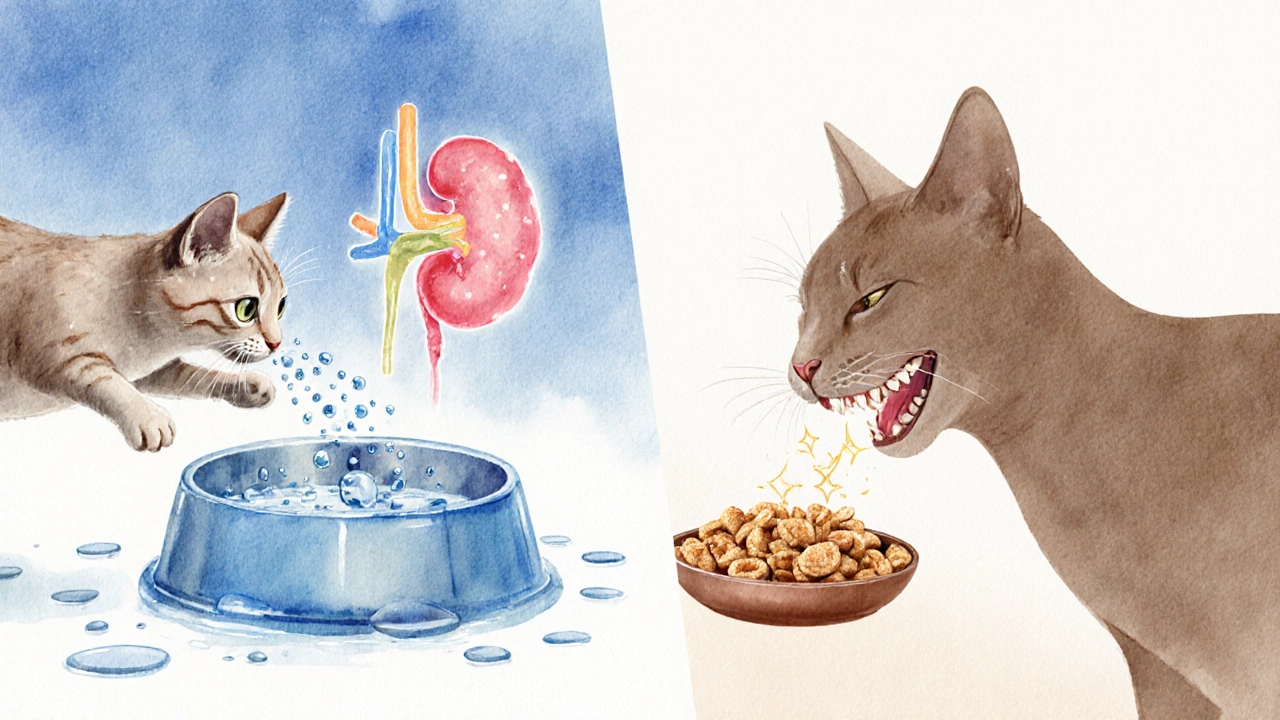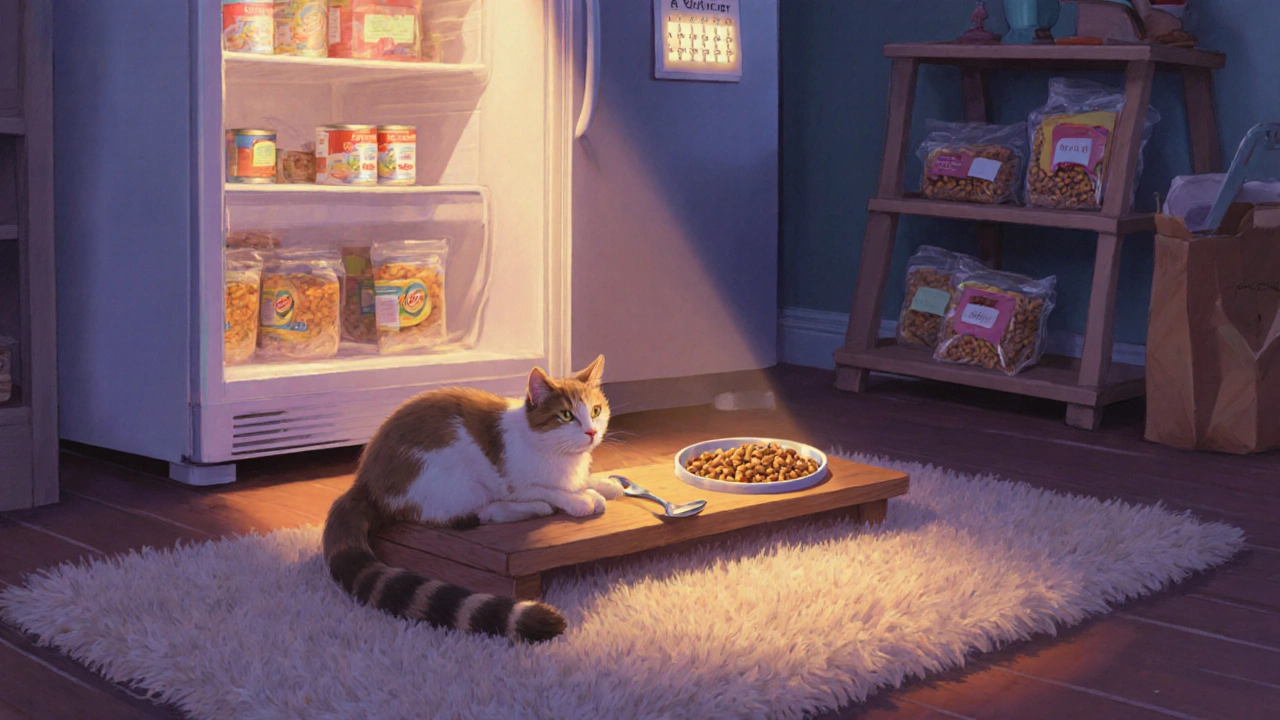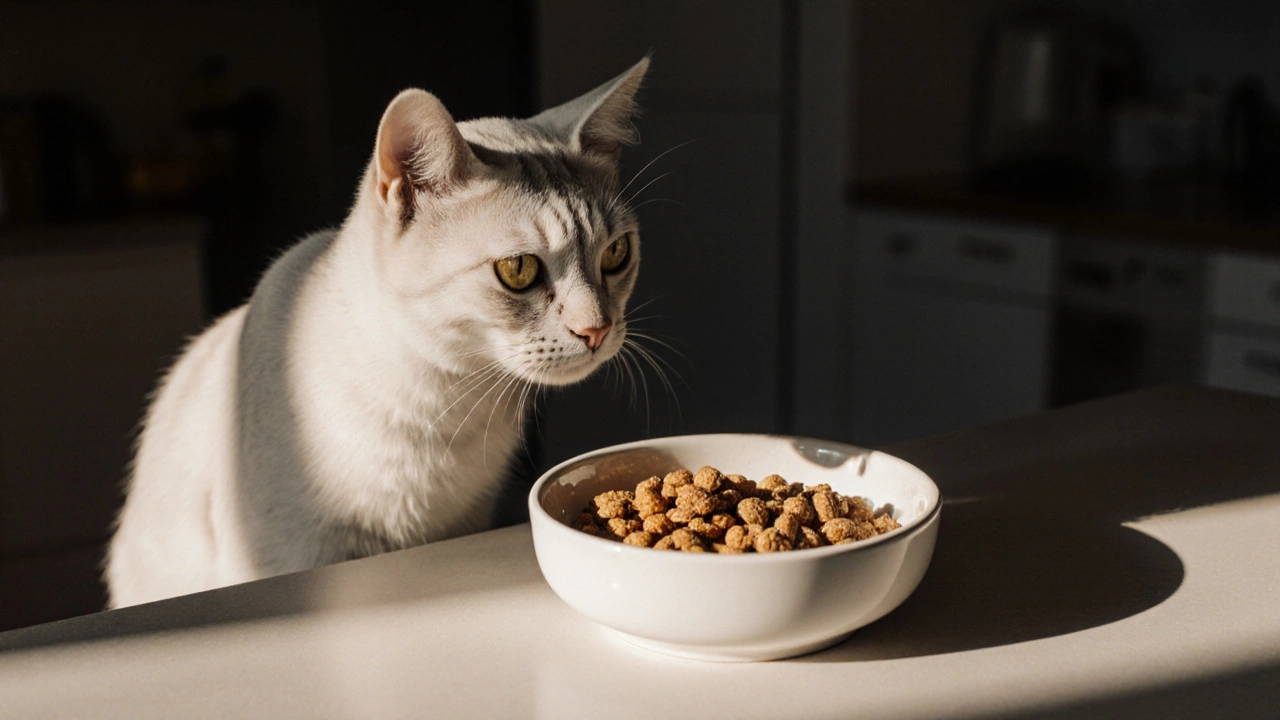Cat Food Ratio Calculator
How to Use This Calculator
This tool helps determine how much wet and dry food to feed your cat based on their weight and daily calorie needs. Enter your cat's weight and target calories, then click Calculate. The result shows how many pouches of wet food and cups of dry kibble to feed daily.
Note: Always consult with your veterinarian before making significant changes to your cat's diet.
Quick Summary
- Combining wet and dry food can boost hydration, texture variety, and nutrient balance.
- Watch calories and portion sizes to avoid weight gain.
- Start with a 50/50 split, then adjust based on your cat's preferences and health.
- Store each type properly to keep flavor and safety intact.
- Regular vet check‑ups help fine‑tune the mix for long‑term health.
Ever wondered whether you can safely mix wet and dry cat food in the same bowl? Many cat owners grapple with this question because they want the best of both worlds - the moisture boost of canned meals and the convenience of kibble. This guide breaks down the science, the practical steps, and the common pitfalls so you can feed your feline with confidence.
Cat is a small carnivorous mammal kept as a companion animal that thrives on a diet rich in animal protein and moisture. In the wild, a cat’s prey provides both, but commercial diets separate those elements into two main formats: wet and dry.
Wet cat food (also called canned food) is a high‑moisture, protein‑rich diet typically packed in cans or pouches. It usually contains 70‑80% water, making it an excellent source of hydration.
Dry cat food (often referred to as kibble) is a low‑moisture, carbohydrate‑based kibble that can be left out for longer periods. Moisture levels hover around 8‑10%.
Understanding the role of cat nutrition is essential when you try to blend these two formats. The goal is a balanced intake of protein, fat, moisture, vitamins, and minerals without over‑ or under‑feeding.
Why Consider Mixing Wet and Dry Food?
Most cat owners start mixing for three main reasons:
- Hydration boost: Wet food’s high water content helps prevent urinary issues, especially in indoor cats.
- Texture variety: Some finicky felines enjoy switching between soft and crunchy textures, reducing boredom.
- Nutrient coverage: Dry kibble often contains added fiber and certain vitamins that complement the protein punch of canned meals.
When done right, the combination can mirror a natural diet more closely than either format alone.
Benefits of Combining Wet and Dry Food
Here are the concrete advantages you’ll see:
- Improved urinary health: More moisture dilutes urine, lowering the risk of crystals and stones.
- Weight management flexibility: You can calibrate calories by adjusting the ratio, which helps if your cat is prone to gaining weight.
- Dental health support: While dry kibble isn’t a substitute for brushing, its crunchy texture can help reduce plaque buildup.
- Palatability: Mixing often makes meals more appealing, encouraging consistent feeding.

Potential Risks and How to Mitigate Them
Mixing isn’t without drawbacks. Keep an eye on these issues:
- Calorie overload: Wet food is calorie‑dense; adding kibble without adjusting portions can lead to weight gain.
- Nutrient imbalances: Some formulas contain excess taurine or sodium. Double‑checking labels prevents over‑supplementation.
- Food spoilage: Wet food left out for more than two hours can develop bacteria. Serve in small batches.
- Texture aversion: A cat used to only dry food may reject a sudden wet addition, and vice versa.
Address these risks by tracking daily calories, rotating brands for variety, and always storing food correctly.
How to Safely Mix: Step‑by‑Step Guidelines
- Calculate daily calorie needs. An average 4‑kg indoor cat requires about 200‑250 kcal per day. Adjust based on age, activity, and vet advice.
- Pick complementary products. Choose a wet formula with similar protein sources as the dry kibble to avoid digestive upset.
- Start with a 50/50 split. For a 200‑kcal day, if the wet food provides 80 kcal per 3‑oz pouch, give one pouch (80 kcal) and the remaining 120 kcal from kibble.
- Mix just before serving. Combine wet and dry in a shallow bowl, stir gently, and let the cat eat within two hours.
- Monitor weight and stool. Weigh your cat weekly for the first month. Soft, well‑formed stools indicate a good balance.
- Adjust ratios as needed. If your cat gains weight, shift toward more dry (lower calorie per gram) or reduce portion sizes.
Remember, each cat is unique. Some may thrive on a 70% wet, 30% dry split, while others prefer the opposite.
Nutrition Deep Dive: Moisture, Protein, and Calories
Here’s a quick snapshot of the key nutrients you’ll juggle:
| Attribute | Wet Food | Dry Food |
|---|---|---|
| Moisture | 75‑80% | 8‑10% |
| Protein (minimum) | 8‑12% (on a dry‑matter basis) | 30‑35% (on a dry‑matter basis) |
| Calorie Density | 80‑100 kcal per 3‑oz pouch | 300‑350 kcal per cup |
| Shelf Life (opened) | 2‑4 hours at room temp | Weeks if kept dry |
| Typical Price per 100g | $0.75‑$1.20 | $0.30‑$0.50 |
Notice the stark difference in moisture and calorie density. When you blend, you’re essentially diluting the dry food’s calories with the wet’s water, which can help control weight while ensuring adequate hydration.

Practical Tips for Daily Feeding
- Store wet food in the fridge. Keep unopened cans in a cool, dry place, and once opened, seal tightly and use within 24hours.
- Use a shallow dish. This prevents the wet portion from sinking and makes it easier for the cat to access both textures.
- Warm wet food slightly. Heating it to body temperature (around 38°C) releases aromas and encourages eating.
- Rotate flavors. Offering chicken one day, fish the next reduces boredom and covers a broader nutrient spectrum.
- Track treats. Treats add extra calories; factor them into your daily total when mixing meals.
Common Mistakes to Avoid
Even seasoned cat owners slip up. Here are the top errors and how to fix them:
- Serving too much wet food. It’s easy to over‑estimate because a pouch looks small. Weigh the portion using a kitchen scale.
- Leaving wet food out all day. Bacteria can multiply quickly. If your cat grazes, offer smaller portions more frequently.
- Mixing foods with differing nutrient profiles. A grain‑free dry paired with a highly processed wet could create excess carbs. Aim for complementary formulas.
- Skipping vet advice. Cats with kidney disease or diabetes need tailored moisture levels. Always get a professional opinion before changing the diet.
When to Consult a Veterinarian
If you notice any of the following, schedule a check‑up:
- Sudden weight change (gain or loss >5% in two weeks).
- Persistent vomiting or diarrhoea.
- Changes in water intake (drinking excessively or not at all).
- Urine that is consistently cloudy, pink, or has a strong odor.
These signs could indicate that the mix isn’t meeting your cat’s health needs.
Frequently Asked Questions
Can I feed wet and dry food together every day?
Yes, daily mixing is fine as long as you balance calories and ensure both foods meet AAFCO nutritional standards. Adjust portions based on your cat’s weight and activity level.
How much wet food should I give to a 4‑kg indoor cat?
A typical 3‑oz pouch provides about 80‑100 kcal. For a 4‑kg cat needing ~200 kcal per day, one pouch plus 100‑120 kcal of dry kibble works well.
Will mixing foods help with urinary tract problems?
Increasing moisture via wet food can dilute urine and lower the risk of crystals. However, you still need a diet formulated for urinary health and regular veterinary monitoring.
Is it okay to add water to dry kibble instead of wet food?
You can moisten kibble with water or broth, but it won’t provide the same protein density or palatability as true wet food. It’s a temporary solution, not a long‑term substitute.
What’s the best storage method for opened canned cat food?
Transfer leftovers into an airtight container, cover tightly, and refrigerate. Use within 24‑48hours to keep flavor and safety.
Mixing wet and dry cat food isn’t a one‑size‑fits‑all recipe, but with the right ratios, quality products, and regular monitoring, it can give your cat a happier, healthier diet.
